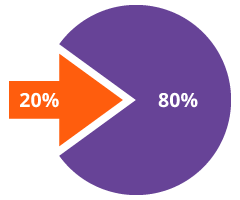
Ever wondered how to be less busy and start getting things done? You start from correct planning.
If you are like most business owners, managers and executives, you probably feel continually swamped at work, with an endless line of tasks that seem to completely take over your day and not give you enough time to complete everything. The same applies to your employees. With the work continuing to build up and the days not growing longer, you and your team need a completely different approach to utilize your time better, cut down on your work and yield better results.
Getting things done with Pareto analysis

No matter what form of business, what products your company sells or what kind of services you provide, a technique known as Pareto Analysis is able to drastically improve your performance. This way, productivity increases, the work load decreases and the business grows, all the the implementation of this single technique. How about doing more by doing less and having a happier team?
The Pareto Analysis is a specific technique used during decision making. It’s designed to select a small level of tasks with the largest overall affect. The idea of the technique is to do the most important 20 percent of the tasks, which results in 80 percent of the most important goals and objectives being achived. So, if you focus in on the 20 percent of work responsible for the larger bulk of tasks, you and the entire office is likely to prosper. You just need to know how to specifically implement the service to work for you and your company.
A good example of this is our task and to-do lists. Quite often we have tens and tens of items on them. In reality, let’s say you have 30 tasks (ouch!) written down, accomplishing 6 or so (20%) of them gives the biggest impact. The rest are often much less important.
Pareto Analysis Steps
Does the Pareto Analysis framework appeal to you? Are you interested in using it to maximize your time and ensure the most important tasks get done?
If so, here are some specific steps you can take as a leader to implement the Pareto Analysis decision-making method into your team’s workflows:
1. Identify the Problems
When using the Pareto Analysis approach, start by identifying the particular problems your company is experiencing and that you need to solve.
To get the most comprehensive list possible, seek feedback from a variety of people. This includes clients as well as members of different teams. Sending out surveys to customers and team members can help with this, as can reviewing formal complaints or helpdesk logs.
2. Identify the Root Causes
Once you have a list of problems that need to be solved, evaluate each problem. Then, think about the root cause or causes that are responsible for them.
3. Score the Problems
After identifying the root cause (or causes) of each problem, assign each of them a score based on importance. This will help you to prioritize the problems and ensure the most important matters (the top 20 percent) get addressed first.
When scoring problems, think about the primary problem you’re trying to solve within your company. If your main concern is profits, for example, you might want to score your problems based on how much they’re costing your business. The most expensive problem will score a 10 on a scale of 1 to 10, for example, and the next most expensive might score a 7 or 8.
Decision making matrixes like the Eisenhower process are another good way to categorize your tasks and choose the most important ones.
4. Group the Problems Together
Look at all of the problems that you’ve listed and consider whether any of them share a common cause and can be grouped together. For example, do you have two problems that are caused by a lack of staff or insufficient training? If so, go ahead group those problems.
5. Add up Each Group’s Scores
Now, take a look at the scores for all of the problems you’ve grouped together and add them up. The group that scores the highest should be your top priority, and the problems within that group should be the ones you tackle first.
6. Get to Work
Once you’ve identified your top priority, it’s time to get to work! Sit down with your team and start brainstorming ways to solve this problem.
Pareto Analysis in Action
If you’re still feeling a little confused about how to use the Pareto Analysis approach, some examples might help. Outlined below are two examples of how businesses might use the Pareto Analysis to set their priorities and have a productive week:
Online Retailer
Imagine an online retailer has an increase in returns. By following the steps outlined above, the retailer’s analysts might find that a glitch on the website is providing shoppers with incorrect information about their products. This, in turn, is leading to higher rates of customer dissatisfaction and more returns.
They might also find that customers are having a poor experience when they reach out for help. As a result, they’re returning items altogether instead of trying to exchange them.
With this information in mind, the analysts might give the technical glitch a score of 10, and subpar customer service a score of 7. From here, they’ll start working on fixing the technical glitch.
Addressing the glitch might provide customer service representatives with more accurate information. This can help them to provide better service without the team having to dedicate all its time and resources to the lower-scoring customer service problem.
Computer Repair Company
In this next example, let’s look at a hypothetical computer repair company with the primary objective of improving customer satisfaction.
After following the steps that make up the Pareto Analysis approach, the owner of the company might find that the highest-scoring problem is that customers have to wait too long for their calls to be answered. The owner might then find, with more digging, that the reason calls aren’t answered quickly enough is that there are too few customer service representatives manning the phones.
By hiring and training more representatives, they will likely see an increase in customer satisfaction without having to worry about addressing every single issue that might have contributed to poor customer service.
Put the Pareto Analysis Approach to the Test Today
Are you ready to give the Pareto Analysis framework a try? Keep the information and examples outlined above in mind and you’ll have no trouble implementing it into your team’s workflow and maximizing productivity.